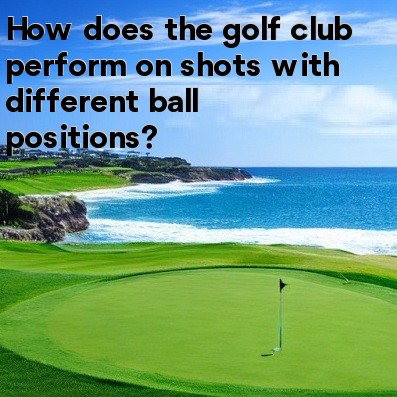
In golf, how does the golf club perform on shots with different ball positions?
The position of the golf ball in relation to your stance can greatly affect the way the golf club performs during a shot. The distance from the ball to your body, as well as its position in relation to the target, can impact the direction, trajectory, and spin of the golf ball. Let's explore how the golf club performs on shots with different ball positions:
- Forward Ball Position: Placing the ball forward in your stance, closer to your left foot (for right-handed golfers), is often preferred for tee shots. This position allows you to make contact with the ball while your golf club is still on the upswing, leading to a higher launch angle and more distance. It also tends to promote a slight fade or straight shot.
- Middle Ball Position: A ball position in the middle of your stance is commonly used for fairway shots with irons. This position helps promote a more neutral ball flight, with less tendency for the ball to curve excessively to the left or right. It allows for solid contact and control over the trajectory.
- Backward Ball Position: Moving the ball backward in your stance, closer to your right foot (for right-handed golfers), is often employed for shots that require a low trajectory. This position ensures that the golf club strikes the ball on a descending path, generating less backspin and creating a lower ball flight. It is commonly used for punch shots, chip shots, and shots from heavy rough.
It's important to note that the impact of ball position may vary depending on other factors such as the type of club being used, the golfer's swing characteristics, and the desired shot shape. Experimentation and practice can help you determine the optimal ball position for various shots.
Aside from the ball position, the angle of attack is another crucial factor that affects the performance of the golf club. The angle of attack refers to the direction and angle at which the clubhead strikes the ball.
- Shallow Angle of Attack: A shallower angle of attack occurs when the clubhead interacts with the ball on a more level or sweeping motion. This type of attack tends to produce higher shots with more backspin, ideal for shots that require maximum carry distance and stopping power on the greens. It is often associated with fairway woods, hybrids, and long irons.
- Steep Angle of Attack: Conversely, a steeper angle of attack happens when the clubhead comes down onto the ball at a sharp angle. This type of attack produces lower shots with less spin, suitable for shots that require a penetrating ball flight or shots from tight lies. It is commonly associated with short irons, wedges, and certain specialty shots around the greens.
To further complicate matters, your angle of attack can also be influenced by your ball position. For example, a forward ball position tends to encourage a shallower angle of attack, while a backward ball position promotes a steeper angle of attack.
In conclusion, the position of the golf ball in relation to your stance and the angle of attack can significantly impact the performance of the golf club on different shots. Understanding how ball position and angle of attack work together can help you execute a variety of shots and better control the direction, trajectory, and spin of your golf ball.





